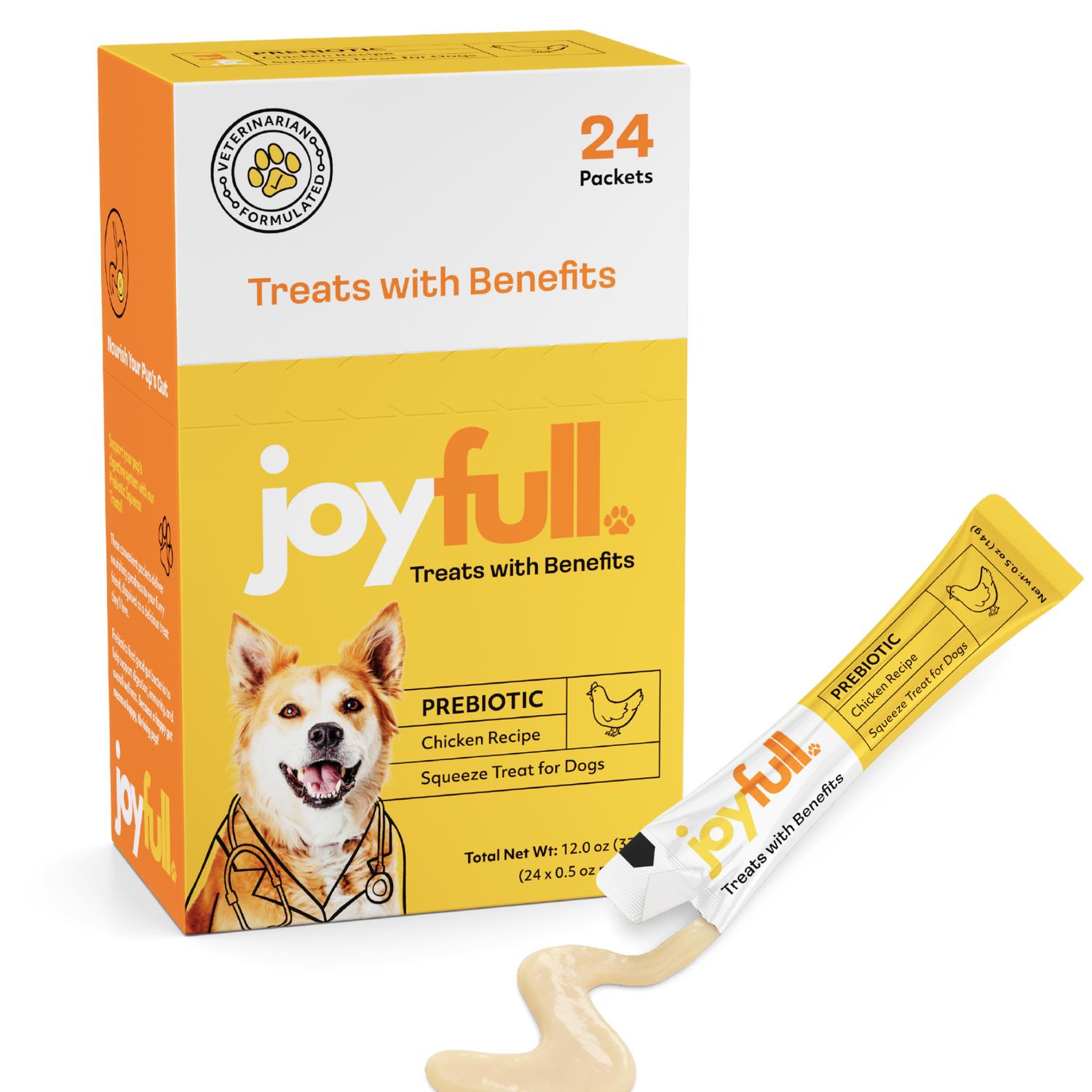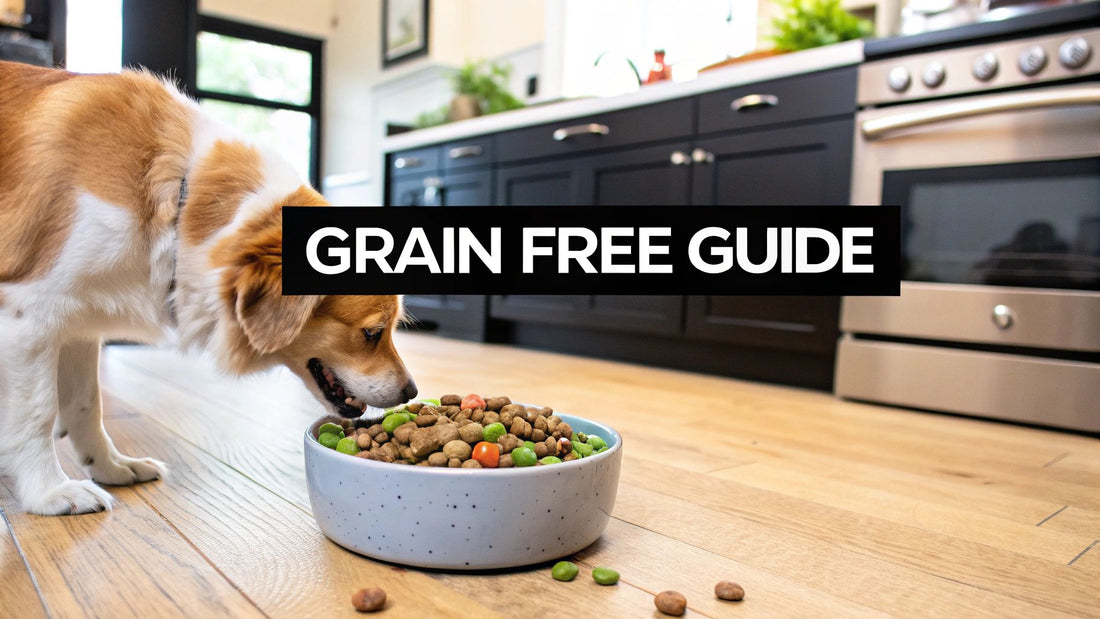
Discover the Best Grain Free Dog Food for Your Pet
When you're on the hunt for the best grain free dog food, you'll quickly realize it's not a one-size-fits-all situation. The "best" food is always the one that fits your individual dog's health profile. For a lot of dogs, especially those with sensitivities, a high-quality grain-free recipe that lists a named animal protein right at the top of the ingredient list is an excellent place to start.
Why Pet Owners Explore Grain Free Diets
The move toward grain-free food isn't just a fad. It's often a thoughtful decision made by concerned owners who see that something is off with their dog. For many, the journey starts with a nagging problem that just won't go away.
Maybe it's a dog that can't stop scratching, leaving their skin red and raw. Or perhaps it's the constant battle with ear infections that never quite clear up, no matter what you try. These are the classic signs that make an owner start looking for answers in the food bowl.
Digestive troubles are another huge trigger. I've heard from countless owners who are tired of dealing with loose stools, terrible gas, or a dog whose sensitive stomach seems to react to everything. After multiple vet visits with no clear solution, exploring a grain-free diet to eliminate common triggers like corn, wheat, and soy becomes a really practical next step.
Could a Grain Free Diet Help Your Dog?
Sometimes, the signs that a food change is needed are subtle. This quick-glance table can help you connect the dots between common issues and whether a grain-free diet might be a path worth exploring.
Is a Grain Free Diet Right for Your Dog?
| Potential Issue | Common Symptoms | How a Grain Free Diet Might Help |
|---|---|---|
| Skin & Coat Problems | Constant scratching, hot spots, dull or flaky coat, excessive shedding | By removing common grain allergens (like wheat or corn) that can trigger skin inflammation. |
| Digestive Upset | Chronic gas, loose stools, vomiting, sensitive stomach | Grains can be difficult for some dogs to digest; grain-free formulas often use more digestible carbs like sweet potatoes or peas. |
| Chronic Ear Infections | Head shaking, smelly or waxy ears, recurring infections | Food sensitivities are a common underlying cause of inflammation that leads to yeast overgrowth in the ears. |
| Low Energy Levels | Lethargy, lack of interest in play, slowing down (not just due to age) | Providing high-quality, easily absorbed protein and fats for energy, without the "filler" carbs that can cause energy spikes and crashes. |
Remember, this is a starting point. If you see these signs, it's a good idea to discuss a potential dietary change with your veterinarian to rule out other medical causes first.
The Pursuit of Better Health and Vitality
It's not always about fixing a problem. Many owners switch to grain-free simply because they want their dog to feel their absolute best. They might feel their dog is a bit sluggish or notice their coat has lost its luster.
Real-world results are what truly convince people. A friend of mine switched her Golden Retriever to a grain-free formula and was amazed when, just a few weeks later, his coat was glossier and he was shedding noticeably less.
I've also seen it make a huge difference for senior dogs. An owner might see their older companion, who had gotten slow and creaky, suddenly have a bit more pep in their step and a renewed interest in playtime after a diet change. These tangible improvements—more energy, healthier skin, better digestion—are powerful proof that you're on the right track.
This hands-on approach is part of a larger movement called 'pet humanization.' As we see our pets more and more as family, we start looking for food that meets the same high standards we set for ourselves, focusing on premium, recognizable ingredients.
A Market Driven by Pet Wellness
This intense focus on our pets' health isn't just changing how we shop; it's reshaping the entire pet food industry. In 2023, the global grain-free dog food market was valued at around $3.5 billion, and it's projected to keep growing.
This growth is fueled by owners like you—people who are more informed and invested in their dog's nutrition than ever before. They're willing to pay for premium foods because they see the direct, positive impact it has on their dog's quality of life. You can discover more details about this growing market and its future.
While it's not a silver bullet for every issue, choosing the best grain-free dog food is a deliberate, caring decision to give your best friend a foundation for a long and vibrant life.
How to Decode a Dog Food Ingredient Label
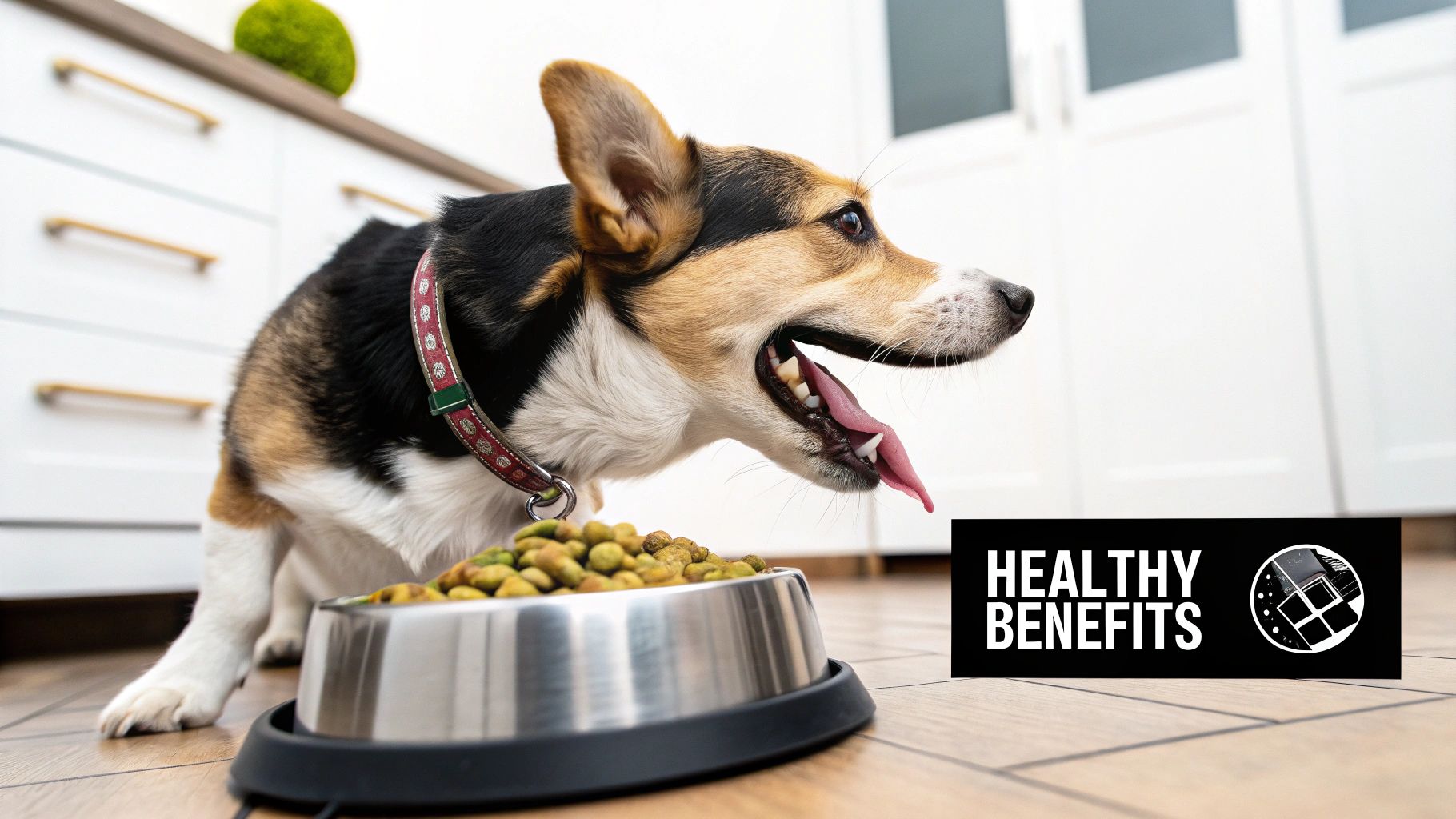
Alright, let's talk about what really matters when choosing a grain-free dog food. You have to look past the beautiful bag and the clever marketing slogans. The real story is on the back, in the ingredient list. It can look intimidating, but once you know a few key things, you'll be able to spot the good stuff from the junk in a heartbeat.
Here's the most important rule of thumb: ingredients are listed by weight. The first five or so ingredients are what make up the majority of your dog’s meal.
Start with the Protein Source
The very first thing you want to see on that list is a named animal protein. I’m talking about specific, high-quality ingredients like "deboned chicken," "lamb," "beef," or "salmon." When you see that, you know the recipe is built on a solid foundation of real, whole-muscle meat.
Be wary of vague, generic terms. Phrases like "meat meal" or "animal by-product meal" are major red flags. Why? Because you have no idea what animal it came from or which parts were used. It’s a sign of inconsistent, lower-quality sourcing.
Now, don't get this confused with a named protein meal, like "chicken meal" or "lamb meal." That's actually a great ingredient. It's simply the named meat with the water removed, creating a highly concentrated and potent source of protein for your dog.
Understand the Grain Alternatives
In a grain-free diet, carbohydrates don't just disappear. They come from other sources that provide the energy, fiber, and nutrients your dog needs.
Here are some of the most common and beneficial grain replacements you'll find:
- Sweet Potatoes: A fantastic source of dietary fiber, vitamin A, and powerful antioxidants.
- Peas and Lentils: These legumes pack a punch with carbs, fiber, and plant-based protein.
- Chickpeas: Another great option offering a solid balance of protein and fiber.
For many dogs, especially those with sensitivities, these alternatives are often far more digestible than common grains like corn, soy, or wheat.
A Quick Insight: The whole point of going grain-free isn't to cut out all carbs. It's about swapping potentially problematic grains for nutrient-dense, easily digestible alternatives that support your dog's energy levels and gut health.
What to Avoid on the Label
Knowing what to steer clear of is just as critical as knowing what to look for. A truly premium food is defined just as much by what it leaves out.
Keep your eyes peeled for these low-quality additions:
- Artificial Colors and Preservatives: Your dog doesn’t care if their kibble is bright red. Dyes like Red 40 or Yellow 5 are purely for human appeal. A good food uses natural preservatives like mixed tocopherols (which is just Vitamin E) or rosemary extract.
- Unnamed "Meat" or "Animal" Products: As I mentioned before, if the brand can't tell you what animal is in the food, walk away.
- Sweeteners: Ingredients like corn syrup or sucrose are cheap fillers with zero nutritional value. They only contribute to unhealthy weight gain and potential dental issues.
The world of specialty dog food is always changing. By 2025, grain-free options are projected to account for about 27% of the market's revenue, and nutritional guidelines are constantly being refined. This directly impacts how the best formulas are made.
For a complete breakdown, our guide on how to read dog food labels goes even deeper into the details.
Finding the Right Food for Your Dog's Unique Needs
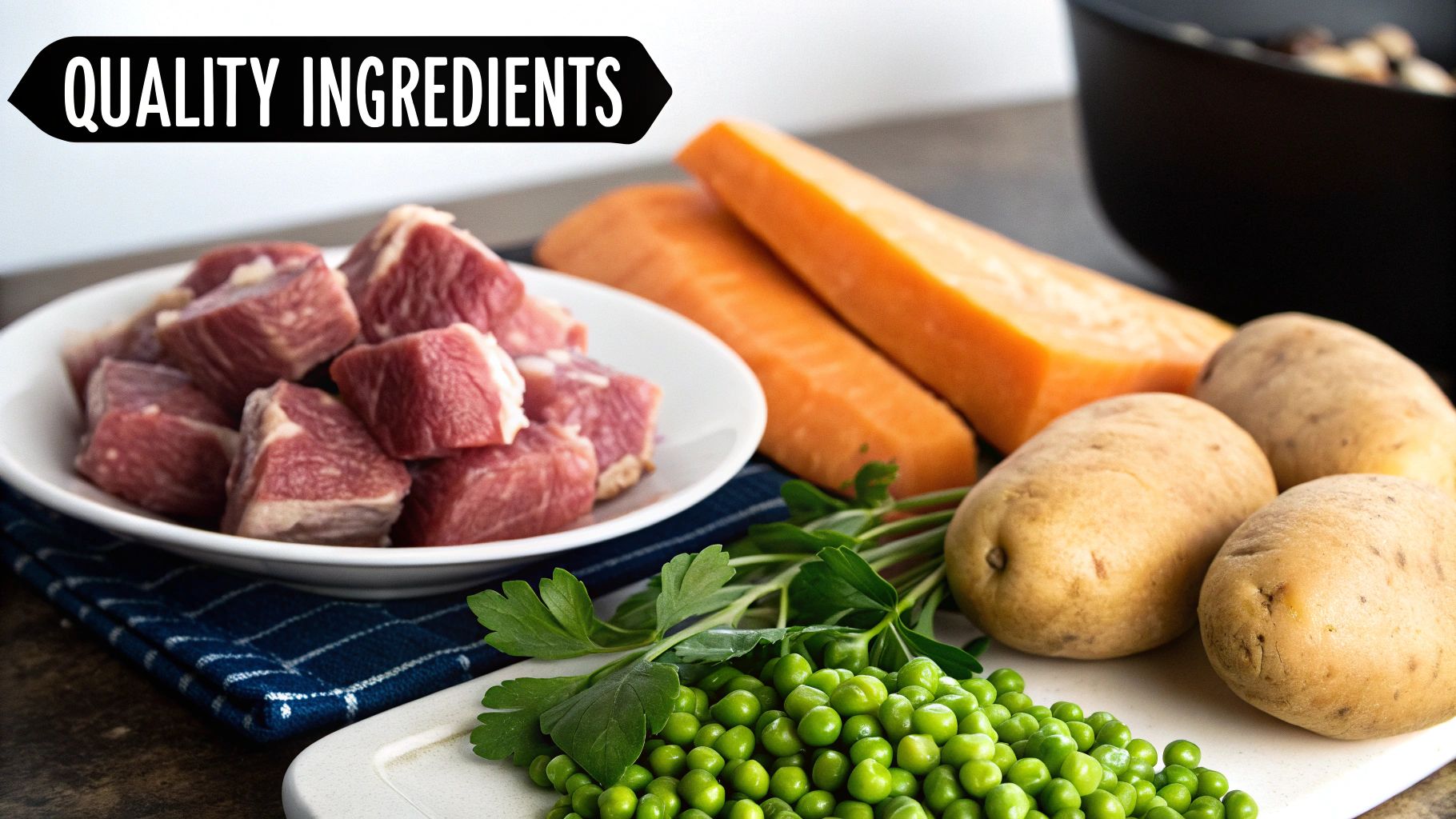
Let's be honest—there's no single bag of food that’s a perfect fit for every dog out there. Finding the best grain-free diet isn't about chasing a "number one" brand; it's about becoming a detective and discovering the ideal formula for your dog. A dog's nutritional needs aren't static; they shift with age, size, and lifestyle.
Think of it this way: you wouldn't feed a growing, rambunctious puppy the same meal as a senior dog who's more interested in snoozing than sprinting. One needs fuel for development, while the other needs support for aging joints and a slowing metabolism. This is why a personalized approach is non-negotiable.
Life Stage and Size: The First Big Filter
Your dog's age and breed size are the two most critical starting points. They immediately narrow the massive field of options. For instance, a formula for a large-breed puppy is carefully crafted with controlled levels of calcium to ensure their bones grow at a steady, healthy pace, which helps prevent joint problems down the road.
On the flip side, a food made for a small-breed adult will feature smaller kibble for their tiny mouths and a higher calorie count to keep up with their zippy metabolism. You can't just pour a German Shepherd's dinner for a Chihuahua and hope for the best.
A "large breed puppy" or "small breed senior" label isn't just marketing fluff. It's a clear signal that the food's nutrient profile is specifically calibrated for those unique physiological demands.
Take senior dogs, for example. As their activity naturally winds down, they often thrive on a diet with fewer calories to keep weight in check. Many also benefit from extra fiber to maintain a healthy digestive system. Matching the formula to their life stage is a simple yet powerful move. If you want to dig deeper, our post on what to look for in dog food is a great resource.
Matching Diet to Daily Energy
Next up: what does your dog's day actually look like? Are they a canine athlete or more of a professional lap warmer? A Border Collie who spends their days training has completely different fuel requirements than a Basset Hound whose main activity is finding the sunniest spot to nap.
- High-Energy Pups: These dogs need a diet packed with high-quality protein and fat to power their muscles and sustain their endurance.
- Couch Companions: Less active dogs can easily become overweight. A formula with fewer calories and higher fiber can help them feel satisfied without adding extra pounds.
Looking for Those Helpful Extras
Beyond the core nutrition, many of the best grain-free dog foods are packed with functional ingredients designed to address specific health needs. These are the smart additions that go above and beyond basic fuel.
To help illustrate this, here's a quick look at how different formulas cater to specific dogs:
Grain Free Formula Feature Comparison
| Dog Profile | Key Nutritional Focus | Example Ingredients to Look For |
|---|---|---|
| Active Adult (e.g., Vizsla) | Muscle maintenance & energy | High-quality animal protein (chicken, beef), healthy fats (chicken fat) |
| Senior Dog (e.g., Labrador) | Joint health & weight management | Glucosamine, chondroitin, L-carnitine, increased fiber |
| Dog with Sensitive Skin (e.g., Westie) | Skin & coat support | Omega-3 & omega-6 fatty acids (from fish oil, flaxseed) |
| Small Breed Puppy (e.g., Yorkie) | Brain & bone development | DHA (from fish oil), balanced calcium & phosphorus |
As you can see, a senior Labrador with achy hips would benefit from a formula fortified with glucosamine and chondroitin. Or, if your bulldog struggles with itchy, flaky skin, a recipe rich in omega fatty acids from sources like salmon oil could provide significant relief. It’s all about matching the ingredients to the dog in front of you.
The Whole Grain-Free Diet and DCM Controversy
If you've started looking into grain-free dog food, you've almost certainly run into the term DCM, or Canine Dilated Cardiomyopathy. It's a serious heart condition where the heart muscle thins and enlarges, making it harder to pump blood effectively. The topic exploded a few years back when the FDA announced it was investigating a potential link between DCM and certain dog foods, causing a lot of worry and confusion for pet owners.
But let's clear the air. The concern wasn't a blanket condemnation of all grain-free foods. The spotlight quickly focused on a specific category of diets often called "BEG" diets—those from Boutique brands, featuring Exotic meats, and that happen to be Grain-free. A common thread among these formulas was a heavy reliance on ingredients like peas, lentils, and other legumes, often listed high up on the ingredient panel.
It's More Than Just "No Grains"
What the research began to uncover was that the problem might not be the absence of grains at all. Instead, the real issue could lie with the presence and quantity of these alternative ingredients. Think of it this way: some formulas were using massive amounts of pea protein or lentils to inflate the overall protein percentage on the bag's label, a tactic that can be cheaper than using high-quality animal protein.
Some leading theories suggest that these legume-heavy recipes could be messing with how a dog absorbs or metabolizes taurine, an essential amino acid for a healthy heart. This could happen even if the food technically meets the minimum taurine levels set by industry standards.
The Bottom Line: This isn't a simple "grains are bad" or "grains are good" debate. The DCM conversation is much more complex, focusing on specific formulations, ingredient quality, and the overall nutritional science—or lack thereof—behind certain recipes.
This is a critical distinction. It means you don’t have to swear off grain-free food forever. A thoughtfully formulated grain-free diet from a company that pours resources into scientific research and feeding trials is worlds away from a trendy boutique food that might be prioritizing marketing over nutritional science.
Your Best Defense: Your Vet and Your Own Research
So, what are you supposed to do with this information? You become a detective, and you team up with your veterinarian. Your vet is your single best resource for navigating this, as they can help you understand the specific risks and benefits for your dog's health.
When you're comparing different brands, here’s what you should be digging into:
- Who is on their team? Does the company employ full-time, board-certified veterinary nutritionists or PhD animal nutritionists? Or are they just getting formulation advice from a third-party consultant?
- Do they conduct feeding trials? The gold standard for pet food is the AAFCO feeding trial, which proves a food performs well in real dogs over time. Many brands simply formulate to meet AAFCO's nutrient profiles "on paper," which isn't the same thing.
- Are they transparent? Reputable companies are proud of their science. They'll be open about their quality control measures, where they source ingredients, and the research they conduct. If a brand is cagey about these details, consider it a red flag.
Ultimately, choosing a great dog food—grain-free or not—requires you to look past the flashy packaging. It's about finding a brand that puts proven nutritional science first, ensuring your dog's long-term health is always the main ingredient.
Making the Switch: A Safe and Gradual Transition to New Food
You’ve done all the hard work and picked out what you believe is the perfect grain-free food for your dog. That's a huge step! But the journey isn't quite over. The single biggest mistake I see owners make is swapping out the old food for the new one overnight.
Think about it from your dog's perspective. Their digestive system is a finely tuned machine, accustomed to the same ingredients day in and day out. A sudden, drastic change is almost guaranteed to cause some digestive drama—we're talking gas, diarrhea, and a very unhappy pup. The secret to a happy tummy is a slow and steady transition.
A 7-to-10-day timeline is the sweet spot for most dogs. This gentle approach gives their gut bacteria time to adjust to the different proteins, fats, and fiber in the new formula.
This handy chart gives you a great visual for mixing the old food with the new over the first week.
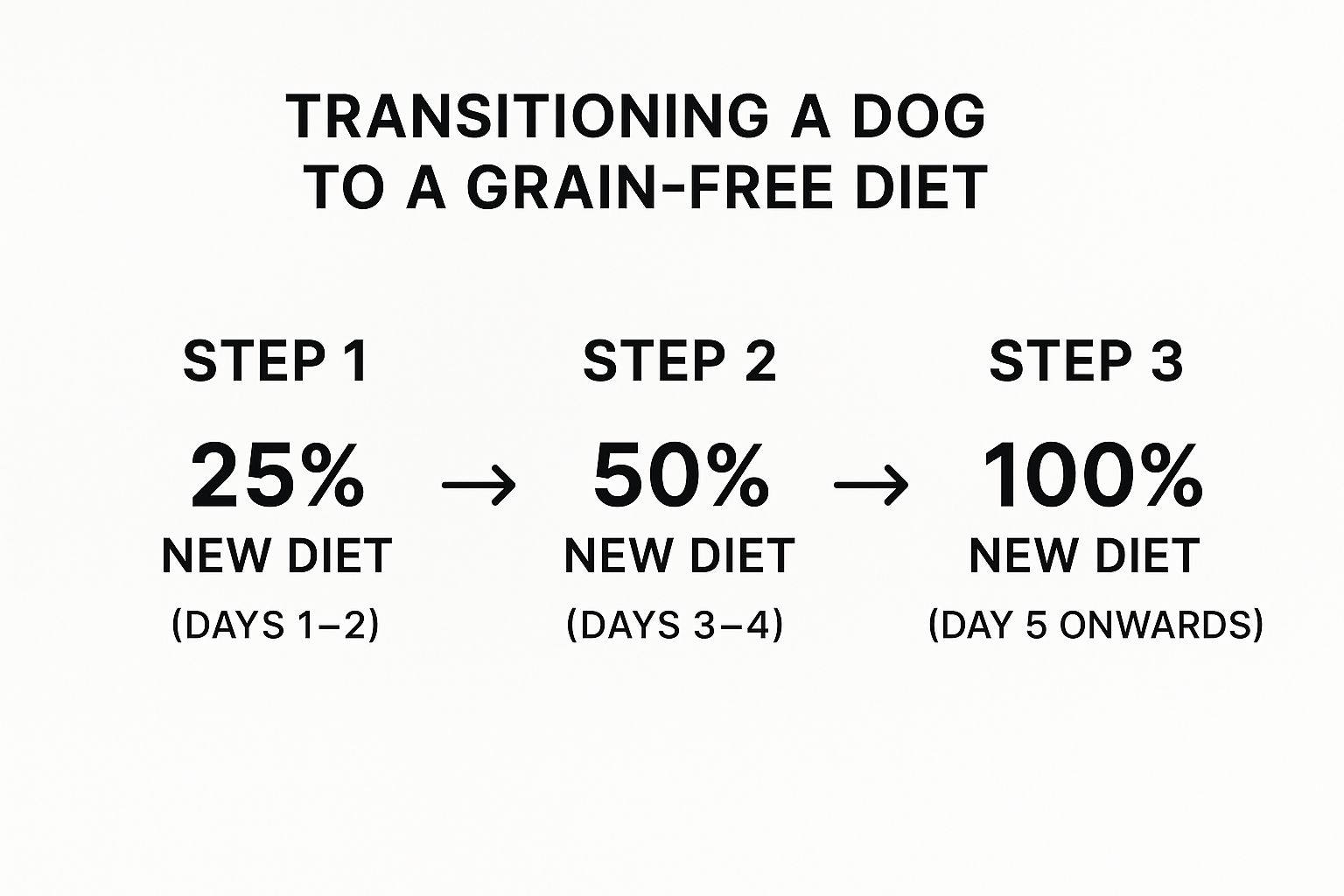
While the infographic shows a five-day path, I've found that stretching it to seven days gives most dogs a smoother experience. There's no prize for rushing this.
The 7-Day Food Swap Plan
Here's a straightforward schedule that I recommend to clients. It’s a simple, proven way to ease into a new diet.
- Days 1 & 2: Start with a mix of 75% old food and just 25% new food.
- Days 3 & 4: Move to an even split—50% old food and 50% new food.
- Days 5 & 6: Now, tip the scales with 25% old food and 75% new food.
- Day 7: You did it! It’s time to serve 100% of their delicious new food.
Expert Tip: Throughout this week, be a detective. Keep a close eye on your dog's stool consistency, energy, and overall happiness. Firm stools and a good appetite are the green flags you’re looking for.
What to Do If You Hit a Snag
Even the most carefully planned transition can have a hiccup. Don't panic if you see a bit of loose stool. It’s the most common issue and usually just means you need to slow down.
Simply hold steady at your current mixing ratio for an extra day or two. Let their system catch up and stabilize before you increase the amount of new food. Sometimes, a picky eater might try to eat around the new kibble (or the old!). This is usually just temporary fussiness.
This transition is also a critical observation period if your dog struggles with sensitivities. For a deeper dive into managing dietary reactions, our guide on the best dog food for skin allergies offers some great long-term insights.
Of course, if digestive issues continue or you’re worried about any changes you're seeing, your veterinarian should always be your first call.
Common Questions About Grain-Free Dog Food
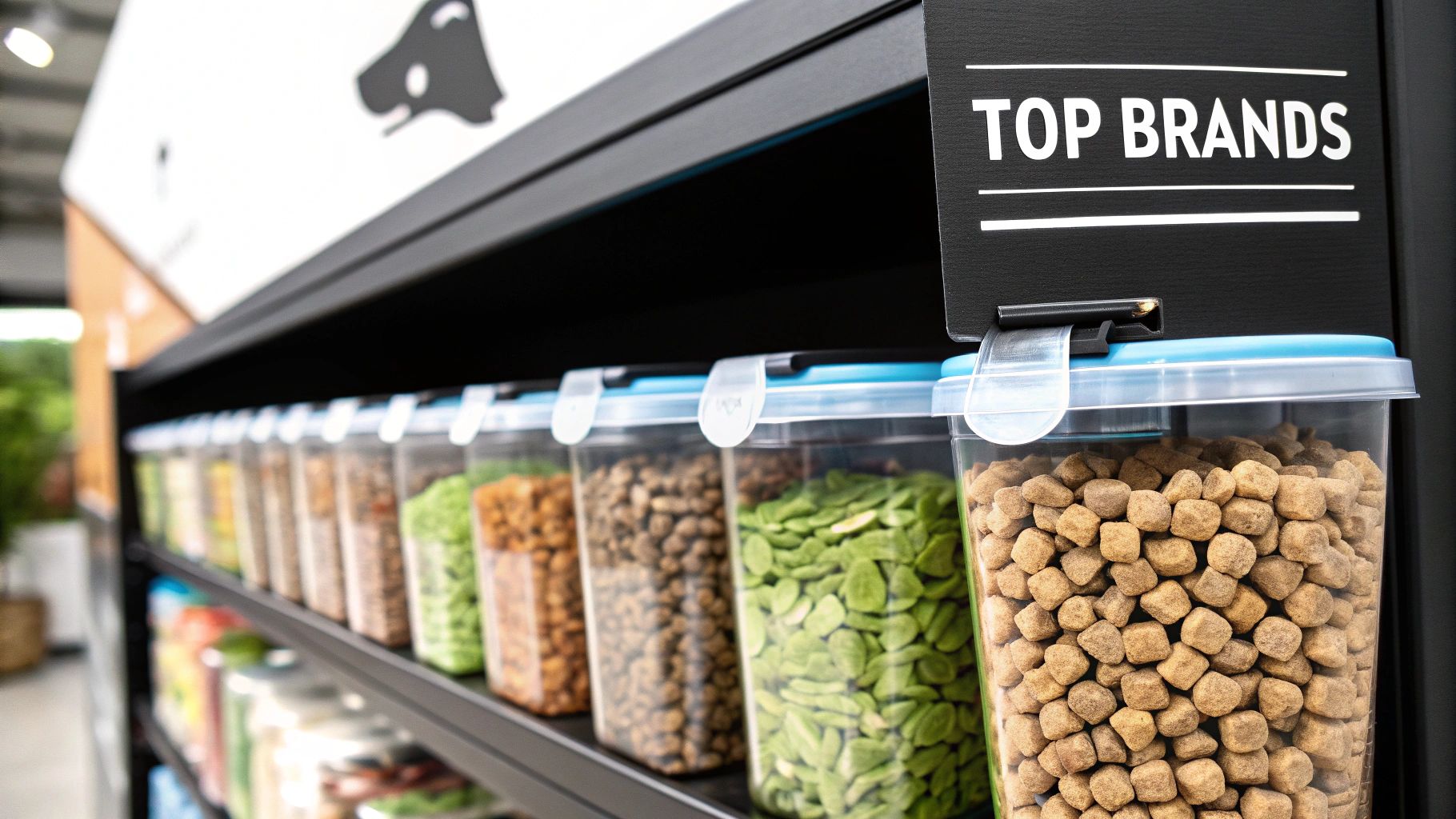
Even with all the research in the world, it's normal to have a few questions rattling around in your head. Changing your dog’s diet is a big deal, and you want to get it right. Let’s walk through some of the most common questions I hear from pet owners when they’re thinking about making the switch to grain-free food.
This isn't just a generic FAQ. It's designed to clear up those last bits of confusion so you can feel genuinely confident in your choice. We'll cover everything from the cost to why your vet needs to be part of the conversation.
Is Grain-Free Dog Food Always More Expensive?
Many grain-free foods do carry a higher price tag, and there's a straightforward reason for it. They're swapping out cheaper fillers like corn and wheat for more expensive, nutrient-rich ingredients like sweet potatoes, lentils, and a higher concentration of quality animal protein.
But don't assume every grain-free option will break the bank. The market has grown, and there are foods available at various price points.
Here’s a practical tip: look at the cost-per-feeding, not just the cost of the bag. Because these formulas are often more calorically dense, you might find you need to feed a smaller portion. This can sometimes even out the cost over the long run.
Should I Talk to My Vet Before Switching Foods?
Yes. Full stop. Consider this step non-negotiable.
Your veterinarian is your number one partner in your dog’s health. They have the full picture—your dog’s age, breed, activity level, and medical history. No one is better qualified to give you advice that's truly personalized.
They are also the best resource to help you make sense of the ongoing DCM conversation and can point you toward brands that have a solid track record for nutritional research and safety testing.
A chat with your vet is what turns a good choice into the right choice for your specific dog. It's the single most important step you can take.
Are Grains Inherently Bad for All Dogs?
Not at all. This is probably the biggest myth in the pet food industry. For the vast majority of dogs, healthy whole grains like brown rice, oats, and barley are excellent sources of fiber, minerals, and energy. They're perfectly healthy.
The whole grain-free movement really took off as a solution for dogs with specific food sensitivities. A small fraction of dogs do react poorly to certain grains, most commonly wheat or corn. However, a true, diagnosed grain allergy is actually quite rare.
The decision to go grain-free shouldn't come from a belief that grains are "bad." It should be a specific choice you make based on your dog's individual health needs—and a decision you make with your vet.
At Joyfull, we believe every pet deserves a diet built on clean ingredients and sound science. Our formulas are crafted to provide exceptional nutrition, giving your companion the foundation for a vibrant, healthy life.
Explore our recipes and find the perfect meal for your pet at https://joyfullpet.com.
